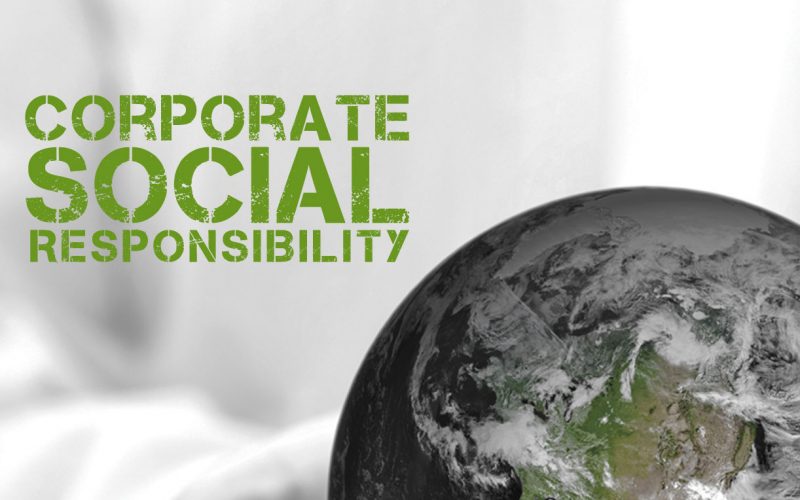Until recently, most large businesses were nearly entirely driven by a single goal: profit. Profit maximization was at the heart of every activity or initiative undertaken.
However, many business leaders have acknowledged in recent decades that they have a responsibility to do more than simply maximize profits for shareholders and executives. Rather, they have a social responsibility to do what is best not only for their companies, but also for people, the environment, and society.
As a result of this realization, companies that practice CSR has emerged. But what exactly is CSR (corporate social responsibility), and what varied shapes may it take in business?
What is the Definition of Corporate Social Responsibility (CSR)?
Corporate social responsibility (CSR) is a sort of business self-regulation with the goal of being socially accountable. There is no one “correct” way for companies to implement CSR; various corporate CSR projects aim to favorably impact the public, the economy, or the environment. In today’s socially conscious world, employees and customers value working with and spending money with businesses that promote CSR.
CSR activities may include the following:
- Policies that require companies to engage with partners who adhere to ethical business practices.
- Profits are reinvested in health and safety or environmental projects.
- Supporting charitable groups in the communities where a company operates.
- At the executive level, promoting equal opportunities for men and women.
Certain components of CSR may be mandated by legislation. Banks and hospitals, for example, are legally mandated to safeguard customers’ personal information. Others are entirely voluntary.
The Definition of CSR in the European Union
In an attempt to provide a framework for companies interested in investing in sustainable development, the European Union issued a Green Paper on Corporate Social Responsibility in 2001, describing CSR as:
“The voluntary incorporation of a company’s social and environmental concerns into its business activities and connections with its stakeholders”. Being socially responsible entails not only meeting all applicable legal duties, but also going above and above and investing “more” in human capital, the environment, and stakeholder relations.
CSR Definition According to ISO 2600
The International Organization for Standardization (ISO) is an international standard-setting organization that, through its ISO 26000 standards on Corporate Social Responsibility, addressed the definition of CSR. ISO defines CSR as follows in these guidelines:
“An organization’s responsibility for the effects of its decisions and activities on society and the environment, resulting in ethical behavior and transparency that contributes to sustainable development, including societal health and well-being; takes into account stakeholder expectations; complies with current laws and is consistent with international standards of behavior;
What Is the Difference Between CSR Definition and ESG Definition?
Although CSR and ESG are frequently used interchangeably, they are not. Yes, both adhere to the principles that profit isn’t everything. Also, that firms must safeguard society and the environment in order to contribute to sustainable growth. Their approach and goal, however, are not the same.
While CSR is concerned with a company’s interaction with its stakeholders as well as its commitment to socially and environmentally responsible activities. ESG, on the other hand, is a capital market term that investors use to indicate the environmental, social, and governance standards against which they would evaluate a company’s response activities.
What Is the Relationship Between CSR and Sustainability?
CSR is unmistakably based on a concern for the environment. However, it mostly depends on what companies may do to assist in achieving a sustainable growth path. However, there are other situations in which we may act in a sustainable manner. For example, how individuals use technology, the food they consume, the mode of transportation they use, or the way they travel. The clothes people buy, how they organize their homes, and how much they consume are all linked to sustainable and ethical conduct. If you want to learn more about this, we recommend reading our sustainability article.
CSR and Impact Assessment
All stakeholders, from consumers to investors to employees, increasingly show interest in how companies are assisting in addressing the world’s major dangers. They want firms to have CSR policies that enable them to be a force for good and contribute to the resolution of challenges. This includes land degradation, ocean acidification, and a lack of sanitation in underdeveloped nations. Random acts of solidarity, on the other hand, are insufficient.
Businesses are expected to have a plan, present it in their CSR reports, and properly measure the impacts they have. They should also show proof of how they are assisting the world to develop sustainably.
CSR: The History And Origins Of CSR (Corporate Social Responsibility)
Origin of CSR Companies
The notion that companies must engage in CSR and play an active part in the struggle for sustainable development dates back to the efforts of several American executives in the 1950s. What were their plans? They believed that if companies focused not only on profits but also on the influence they have on society and the environment, they would reap additional benefits.
For example, if a company pays its employees well, it may spend more on salaries. The employees’ purchasing power grows, as do their chances of purchasing the company’s products. Furthermore, if a company manages its environmental effects more effectively, it will save money in the short term by avoiding fines and in the long term by eliminating the need to manage natural disasters.
Howard Bowen released “The Social Responsibility of the Businessman” in 1953, in which he discusses why companies should be interested in being more socially and environmentally accountable and provided the first “recognized” definition of CSR.
Furthermore, as environmental concerns, as well as economic and social difficulties, grew in the second part of the twentieth century, corporate (social) responsibility became a major issue. Consumers began to become more critical of companies. They expect them to be more responsible in general, as well as more respectful of the law and the environment.
CSR Development and Institutionalization
In the 1990s and 2000s, governments in a number of nations around the world began to implement legislation that laid the groundwork for modern CSR. NRE regulations in France were the first to compel companies to declare their performance in terms of sustainable development. Following these rules were various regulations such as the Grenelle Laws or the Laws of Vigilance.
Following that, companies became conscious of the necessity to begin investing in CSR so that they did not fall behind their competitors. CSR began to be regarded and used as a tool for management, communication, and business development at this moment. CSR became important in improving company image among consumers, improving internal communication and productivity, and lowering costs by making organizations more effective in managing energy and resources.
Today, as the globe faces several social and environmental concerns, it is difficult to find medium/large-sized companies that do not have a CSR report, a CSR department, or a person in charge, or at the very least a CSR-focused communication strategy.
The CSR Roadmap and Today’s CSR Tools
Many technologies are being created to help companies better measure their performance and activities in terms of long-term development. Companies, for example, are now using LCA (Life Cycle Assessment) to quantify their greenhouse gas emissions and environmental consequences. Also, they use CSR or sustainability reports to assess and disclose their good and negative contributions to the environment and society. Some do it because it is required (for example, by the EU for large corporations). Others do it because they wish to improve their reputation and employer branding.
On a worldwide scale, there is no “law” that requires companies to implement a CSR strategy. Nonetheless, many jurisdictions have adopted a set of legislation that frames CSR, particularly by urging companies to be more responsible.
On the other side, there is an international organization that publishes guidance for companies to use in developing their CSR strategy. The ISO (International Standard Organization) provides a standard frame of reference for companies to implement their CSR strategy.
CSR Regulation and Standards Europe
In general, there is no European standard that establishes CSR performance standards as such. There are no global CSR rules. For example, there is no policy requiring companies to cut their greenhouse gas emissions or to adopt a waste reduction strategy.
According to the EU’s 2014/95 Directive, large and public-interest companies, on the other hand, must provide non-financial information about how they are dealing with environmental and social concerns.
Some countries, such as France, can still rely on state organizations such as ADEME and AFNOR for assistance. These organizations are in charge of assisting companies in their CSR and sustainable development efforts. They frequently serve as a link for the creation of ISO standards.
CSR In The United States And CSR Standards
CSR in the United States is founded on a different understanding of responsibility than that which is commonly seen in European countries. Whereas in Europe, CSR is generally governed by legislation, standards, and good practices (a type of institutionalized CSR), the legal definition of CSR in the United States is more ambiguous. Thus, in the United States, a more altruistic and individual definition of CSR predominates, where business as usual is regarded as “normal,” and making a profit to benefit society or the environment is frequently regarded as an act of charity.
China’s CSR Standards
CSR is thriving in China. This is a country that is putting more controls and regulations in place to ensure the responsibility of its businesses, but it is also a country where the image and reputation of companies are firmly related to their ability to improve social welfare or invest in causes. Because of the pervasiveness of social networks in the middle-class population, CSR is becoming an increasingly crucial concern for the reputation of Chinese companies.
India CSR Standards
India has shifted away from a highly centralized definition of CSR and toward a more traditional and open approach to CSR. Today, however, the philanthropic ideal rooted in Indian philosophy (and arising from the Gandhian tradition) bears fruit. CSR is particularly vibrant in India, which, like China, appears to have a promising CSR future.
Today’s CSR Trends
CSR is currently evolving. Companies aim to define innovative ways to contribute to sustainable development in order to improve not only their image but also their performance and possibilities of long-term investment and thriving. CSR is also benefiting from technical and economic advancements. Best practices are likely to change extremely quickly today.
CSR (Corporate Social Responsibility) three main areas
Corporate social responsibility is a fairly ambiguous topic. As a result, there are numerous approaches to grasping the fundamental concept. Stefanie Hiss’s responsibility model is a relatively popular model. She divides CSR into three basic categories, each called for the nature of their work:
- The internal sphere of responsibility includes all internal strategies and activities that are not visible to the public yet are critical to the company’s ethical attitude.
- The medium area of responsibility encompasses all disciplines that are publicly effective and have a direct impact on the environment and society, but are nevertheless an expected part of the working process.
- The external field of responsibility encompasses all actions that necessitate action, such as when a company becomes charitable (primarily monetarily) and disrupts or changes its everyday work routines.
#1. Internal responsibility
The internal area of responsibility encompasses all internal procedures that have an impact on the business strategy. Internal responsibility is typically the responsibility of company executives and influences critical decisions such as which business partners are acquired, one’s own market responsibility in terms of monopolies, fair and realistic growth plans, and healthy profitability.
In an ideal world, the firm’s moral compass plays an essential part in decision-making; nonetheless, it is sometimes difficult to tell from the outside how seriously a company takes its internal area of responsibility. CSR management that is apparent to the outside world is at the very least an indicator that the internal strategy considers moral standards.
#2. Medium Area of Responsibility
The intermediate area of responsibility encompasses all of a company’s actions whose effects on the environment and society may be quantified directly or indirectly. This includes CO2 emissions, air pollution, and employee working conditions. This includes appropriate supply chain management because collaboration with morally dubious companies ultimately benefits their corporate policies.
Corporate social responsibility (CSR) in the middle area of responsibility is the most difficult for many large firms to organize. However, it has grown in importance – exactly because this is where the most damage can occur. This applies not only to the environment and society, but also to the employees, stakeholders, and reputation of a company.
1. Stakeholders:
According to Stefanie Hiss, the intermediate area of responsibility mostly refers to stakeholders. Stakeholders are those who have a vested interest in the company’s processes, working conditions, and, in most circumstances, its success. Important stakeholders include the following individuals and organizations:
2. Employees
Companies owe it to their employees to provide a pleasant working environment and to provide information about career possibilities and hierarchies as transparent as possible. This also encompasses the problem of fair payment and profit-sharing, as well as contract duration limitations.
The constructive relationship with trade unions when they operate within the company is another critical component for healthy CSR in this area. Strikes may occur in severe instances if companies do not take their social responsibility to their employees seriously. Unacceptable working conditions have also called into doubt human rights organizations and state authorities. Employees frequently make their issues public, which means that the news can spread like wildfire through social media and create significant image damage.
3. Providers of equity and debt capital
Investors are clearly interested not just in the company’s success, but also in fair cooperation. Above all, listed companies face significant risk if their dealings with business partners and investors are morally dubious or dishonest.
4. Clients
Product companies should not deceive their customers. A company, particularly in the case of consumer goods such as food, has the responsibility to appropriately notify the buyer about the product’s production and composition. Many buyers value knowing the origin of the product and the raw materials used. If a company portrays itself to the outer world as environmentally benign, yet uses caged production eggs or components from ecologically hazardous production plants in the manufacture of a product, it may lose a significant consumer base.
The client is by far the most important stakeholder for many companies. Poor CSR management is sometimes to blame when a business fails to take its social responsibility to its customers seriously (if any).
5. Residents of the area
Companies based in cities or, at the very least, in close proximity to settlements have a responsibility to local citizens. The operation should not have a negative influence on the residents’ quality of life. This is true, for example, of noise and pollution in the environment. People in many countries continue to suffer from poor living conditions while powerful corporations disregard their social responsibilities.
In the worst-case scenario, companies pollute drinking water, create unbearable noise, pollute the air, and harm the surrounding flora and fauna. If such injustices are made public, the company faces not just reputational harm, but also problems with the law and environmental organizations.
6. Governmental organizations
Companies must abide by the laws of the nations in which they operate. This includes easy and honest collaboration with government agencies such as health and safety departments and health offices, for example. Regular checks and assessments are required to ensure that the quality requirements and rules stipulated by the legislator are met in manufacturing facilities.
7. Media
The “fourth estate’s” responsibility involves the most thorough reporting of grievances in companies. As a result, the interaction between journalists and business is frequently two-sided: on the one hand, a company tries to present itself as well as possible so that the media may help build a favorable image of them through their CSR reporting. Companies that do not live up to their corporate duties, on the other hand, can swiftly have their image harmed if the media speak out about it. As a result, media representatives are not always welcome on company grounds.
Because corporate social responsibility is not regulated by the government, the media is frequently compelled to notify the public about corporate wrongdoing. In general, good CSR management entails an open and honest engagement with the media. However, journalists will rarely report on a company’s great performance, preferring to focus on acts of malfeasance because negative coverage sells better.
#3. External area of responsibility
Many companies, as part of their corporate social responsibility, not only focus on internal processes. They also assume social responsibility outside of their own operations. The term “corporate citizenship” is frequently used interchangeably with the word “external area of responsibility,” and the following are some examples of what it entails:
1. Contributions
Corporate donating is the most common way for people to actively participate in corporate responsibility. However, these donations are frequently tied to the sale of goods and thus designed to generate greater sales numbers, such as by pledging to donate an example of the earnings each product sold to a good cause. Many companies also participate in activities where employees can participate, such as marathons and fundraisers. Of course, all of this generates positive publicity for the companies, but it does not negate the overall benefit of their efforts. Such charitable gatherings are ultimately rewarding for all those involved.
2. Sponsoring
Companies frequently fulfill their social responsibility by sponsoring specific programs or donating to charitable organizations. In exchange, the companies profit from being connected with these institutions and are positively praised by them. This frequently assists companies in improving their reputation with local inhabitants, for example, by financing civic projects and regional festivals.
3. Social activities
Companies are frequently eager to provide employees time off to participate in social events. Alternatively, paid time for charitable activity is governed by employment contracts, such as when employees are given half a working day every quarter for certain activities. As a result, many companies are willing to support and even reward their employees’ social efforts by classifying these activities as work hours.
CSR Communication
In recent years, CSR communication has been one of the most discussed and implemented sectors. Companies are searching for innovative ways to publicize their activities, get public support, and account for their CSR image.
SMEs and CSR (small and medium-sized business)
The definition of CSR in SMEs is unique to SMEs, as CSR is primarily a concept for large companies. In Europe, for example, most CSR rules are aimed at large or even very large companies: reporting is mandatory for companies with more than 500 employees.
Furthermore, in the setting of a small business with limited resources, investing in CSR may appear challenging, if not impossible. However, CSR is increasingly being defined as a management and performance tool for SMEs. CSR has a high return on investment for SMEs, and more and more tools are becoming available to help companies get started with CSR.
CSR Categories
Although corporate social responsibility is a broad term that each company interprets and implements differently, the basic premise of CSR is to operate in a way that is economically, socially, and environmentally sustainable.
In general, corporate social responsibility projects are divided into the following categories:
#1. Environmental responsibility
Initiatives promoting environmental responsibility seek to reduce pollution and greenhouse gas emissions while also promoting the sustainable use of natural resources.
#2. Responsibility for human rights
Initiatives for human rights responsibility include offering fair labor practices (e.g., equal pay for equal work) and fair trade practices, as well as opposing child labor.
#3. Philanthropic responsibility
Philanthropic responsibility might include funding educational programs, supporting health initiatives, donating to causes, and assisting with community beautification projects.
#4. Financial responsibility
Economic responsibility projects entail enhancing the firm’s business operations while participating in sustainable activities, such as employing a new manufacturing process to reduce waste.
CSR Business Advantages
In some ways, corporate social responsibility can be viewed as a form of public relations. However, it goes beyond that, as corporate social responsibility can improve a company’s competitiveness. The following are some of the business advantages of CSR (corporate social responsibility) :
- Improved brand awareness, recognition, and reputation
CSR brings value to businesses by building and sustaining a positive company reputation and/or brand equity.
- Boosted customer retention and sales
Customers of a company that practices CSR believe they are assisting the company in supporting worthy causes.
- Cost-cutting measures in the workplace
Investing in operational efficiencies results in lower operational costs and a lower environmental impact.
- Keeping crucial and exceptional staff on board
Employees generally remain longer and are more engaged in their business when they know they work for a company that implements CSR.
- Easier funding access
Many investors are more inclined to back a business that practices CSR.
- Reduction in regulatory burden
Strong relationships with regulatory organizations can aid in reducing a company’s regulatory burden.
Positive Examples of CSR Corporate Social Responsibility Implementation
CSR is visible when companies form foundations, sponsor social programs, and participate in fundraising galas. However, CSR must be evaluated in relation to a company’s size and scope. Companies that operate globally but have their headquarters in an affluent country should also engage in social activities in the poorer countries where their products are manufactured.
CSR can be fulfilled in a variety of ways: for example, a small local company already acts in a socially responsible manner when it is involved in a specific project; a small financial injection for the local city park can mean that CSR has been positively implemented just as successfully as the company offering assistance in the event of a natural disaster. Examples of companies that have excelled in the field of corporate social responsibility are shown below.
#1. Ben and Jerry’s
Ben & Jerry’s is famous around the world for its signature labeling and bizarre – but tasty – ice cream varieties. They have always done things their own way since their humble beginnings in 1977, and they have retained a strong sense of economic and social duty in the way they run their business.
Ben & Jerry’s corporate social responsibility extends across all aspects of their business. They are committed to using only Fairtrade, non-GMO ingredients in their products, as well as supporting sustainable agriculture techniques and ethical dairy cow treatment. They have sworn to run the company in such a way that only sustainable growth is accomplished, and that the development of their people comes first. Their social missions, on the other hand, have been the most noticeable, having sponsored a variety of causes at the local, national, and worldwide levels. These are some examples:
- One percent for Peace was founded in 1988 to promote global peace activities and projects.
- Drilling Isn’t the Answer: a demonstration against oil drilling in the Arctic National Wildlife Refuge in 2005.
- Cool Your Jets is a global project that encourages consumers to offset their automobile emissions with air travel.
- The company was a staunch supporter of the 2011 Occupy movement.
#2. IKEA
IKEA is one of the world’s greatest home furnishing companies, and it has taken on the responsibility of assisting in the fight against global poverty and living circumstances in a variety of spectacular ways. As part of their “people and planet positive” credo, they want to celebrate sustainable living in all of its forms, from the materials we use to how we get our energy.
The IKEA Foundation was established to handle the company’s global corporate social responsibility programs. It has donated €1 to Save the Children for every soft toy sold since 2003, with over 104 million Euros (as of 2014) pledged to aid programs in India, Sri Lanka, and Sudan, to name a few. In recent years, IKEA has collaborated with the United Nations Refugee Agency to promote Brighter Lives for Refugees, bringing light and renewable energy to refugee camps in Asia, Africa, and the Middle East.
#3. Bosch
Several philanthropic foundations are run by the electronics maker. The most well-known is the Robert Bosch Stiftung, which works in health, research, society, education, and international education. The Robert Bosch Stiftung focuses on humanitarian causes while also developing its own initiatives.
Bosch also has foundations all over the world that aim to improve the quality of life for individuals who live in close proximity to its manufacturing locations. The Bosch India Foundation strives to enhance medical treatment in India’s poorest areas, particularly for sick children and pregnant women. In Brazil, the Instituto Robert Bosch runs various educational institutions and is involved in the fight against poverty and drug misuse. Bosch also runs various foundations for its multiple manufacturing locations in China, with the goal of eliminating poverty and improving educational opportunities. Bosch, for example, assists first-year students by covering their university costs for the first semester. In addition to its local foundations, Bosch maintains a number of worldwide foundations dedicated to refugee aid and catastrophe relief.
What should you avoid while Developing a CSR Business Model?
Though there are a few restrictions, becoming a socially responsible business can be simple.
To begin, businesses should avoid participating in charity endeavors that are unrelated to their primary business focus or that in any way contradict the company’s ethical standards. Instead of donating money to a completely unrelated group, pick a nonprofit that your company supports or a community project.
Second, don’t only leverage CSR chances for the marketing goals of your business. Running a corporate responsibility CSR campaign as a quick marketing strategy, according to Schmidt, can backfire if your business does not follow through. Instead of performing a one-time deed, you can gradually implement socially responsible CSR business practices. Employees and customers, according to Schmidt, respond favorably to companies that embrace long-term social responsibility.
Finally, if you are considering sustainable activities that are not yet legally mandated, don’t put it off. By implementing socially responsible practices early on, you may set the standard for your sector and refine your approach.
Taking up CSR efforts benefits everyone involved. Your activities will not only appeal to socially conscious consumers and employees, but they will also make a genuine difference in the world.
Companies that Practice CSR
If you’re seeking CSR inspiration for your business, here are six significant companies that practice corporate social responsibility.
#1. Lego:
The toy company has committed millions of dollars to address climate change and decrease waste. Reduced packaging, the use of sustainable materials, and investments in alternative energy are among Lego’s ecologically conscious activities.
#2. TOMS:
TOMS distributes one-third of its net income to nonprofits that promote physical and mental health, as well as educational opportunities. As of April 1, 2020, all charity donations will be directed to the TOMS COVID-19 Global Giving Fund.
#3. Johnson & Johnson:
The company is working to reduce its environmental effect by investing in a variety of alternative energy sources. Johnson & Johnson also works to provide communities with clean, safe water on a global scale.
#4. Starbucks:
In order to diversify its workforce, the global coffee company has created a socially responsible hiring process. Their initiatives are aimed at employing more veterans, young individuals just starting out in their professions, and refugees.
#6. Google:
Google has proved its environmental commitment by investing in renewable energy sources and sustainable offices. Sundar Pichai, the company’s CEO, is also known to take positions on several social issues.
#7. Pfizer
Pfizer’s healthcare programs reflect the pharmaceutical company’s emphasis on “corporate citizenship.” Among the company’s objectives include raising awareness about non-infectious diseases and offering accessible health care to women and children in need.
What are the challenges of implementing a CSR program and how can they be overcome?
Challenges of implementing a CSR program include a lack of resources, resistance from stakeholders, and a lack of understanding of the importance of CSR. These challenges can be overcome by involving stakeholders in the development of the CSR program, providing training and education, and by measuring and reporting on progress regularly.
How can businesses ensure that their CSR initiatives are effective and make a positive impact?
Businesses can ensure that their CSR initiatives are effective by setting specific, measurable, and achievable goals, involving stakeholders in the development and implementation of initiatives, and by tracking and reporting on progress regularly. Additionally, businesses can conduct regular assessments to identify areas for improvement and make necessary adjustments.
What is the role of stakeholders in the CSR initiatives of a business?
Stakeholders play a critical role in the CSR initiatives of a business by providing feedback and suggestions, and by holding the business accountable for its actions. Additionally, stakeholders can provide valuable insights and resources to help a business achieve its CSR goals.
How can businesses communicate their CSR initiatives and impact to stakeholders?
Businesses can communicate their CSR initiatives and impact to stakeholders through a variety of channels such as annual reports, websites, social media, and direct communication.
CSR FAQ’s
What is the main purpose of CSR?
CSR’s ultimate goal is to maximize shared value among firms, employees, customers, shareholders, and members of the community. While the specific value for each of these stakeholders varies, the mutually beneficial character of CSR projects can be maintained.
Why is CSR important to media?
Aside from raising broad knowledge of an organization’s objectives, social media users can promote involvement, increase impact, and alter public dialogue to be more consumer-driven, which gives credibility.
How do you promote CSR initiatives?
Communicate with everyone – softly at times, loudly at others. Publicize your activities to all employees internally and to all other stakeholders as needed. Invite civic, religious, and corporate leaders to see what you’re doing and to join you in your efforts.
Why should you communicate about CSR?
In order to foster business image and improve reputation, CSR actions must be conveyed to society and stakeholders. CSR communication also strengthens ties with stakeholders and recruits more skilled personnel.
Related Articles
- Sustainable Competitive Advantage: Simple Steps to Gain a Sustainable Competitive Advantage
- CORPORATE FINANCE: The Complete Guide (+ free courses)
- SBA 8A: Overview, Certification, Application, Programs, Checklist
- Funding Opportunity – Global Green Grant Fund
- Corporate Strategy: Levels of Corporate Strategy, Jobs With Examples
- Social Marketing Strategy: Definition & Example






